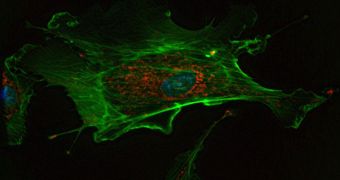A group of scientists from the University of California in Los Angeles (UCLA) announces the creation of a new screening method for determining the safety of large batches of metal-oxide nanomaterials.
Their achievement is very important, considering that the industry currently developing around engineering nanomaterials for specific applications is bound to be worth more than $1 trillion very soon.
Although nanoparticles of various types are being used increasingly often in cosmetics, paints, sunscreens and many other applications, scientists are not really sure about how safe they really are.
In other words, they cannot say for sure how the unique semiconducting properties of these materials interact with biological tissue and process. This is why the UCLA team conducted its investigation.
Metal-oxide nanomaterials have properties that could easily cause significant troubles for animals, humans and the environment. What experts need is a method of gaging their safety, the team says.
The new screening method does exactly that. It helps scientists determine the potential hazards of different nanomaterials and take appropriate actions to prevent any type of negative side effects.
Additionally, the technique allows for larger quantities of these materials to be tested at once, improving on the time and effort that are currently necessary for conducting such complex studies.
Details of the new study appear in the latest issue of the esteemed scientific journal ACS Nano, which is edited by the American Chemical Society (ACS). UCLA expert Haiyuan Zhang was the lead author of the research paper, while Dr. Andre Nel, also at the university, was the senior author.
Semiconductor nanomaterials – like their larger-scale counterparts – work by injecting or extracting electrons from various other materials. The trouble is that the metal-oxide version also has a similar effect when brought into contact with electronically active molecules in the human body.
Nerve cells called neurons transfer electrical potentials alongside their length, delivering impulses from the brain to muscles and other organs. When dangerous nanomaterials are also inserted in the body, they produce reactive oxygen molecules that damage all types of cells.
“The ability to make [predictions such as those enabled by the screening technique] starting with cells in a test tube, and extrapolating the results to intact animals and humans exposed to potentially hazardous metal oxides, is a huge step forward in the safety screening of nanomaterials,” Nel says.
The expert is the chief of the UCLA David Geffen School of Medicine's Division of Nanomedicine. He also works at the California NanoSystems Institute, and is the director of the University of California Center for Environmental Implications of Nanotechnology.
“We can now further refine the testing of an important class of engineered nanomaterials to the level where regulatory agencies can make use of our predictions and testing methods,” concludes Zhang, a postdoctoral research scholar at the UCLA CNSI Center for Environmental Implications of Nanotechnology.

 14 DAY TRIAL //
14 DAY TRIAL //